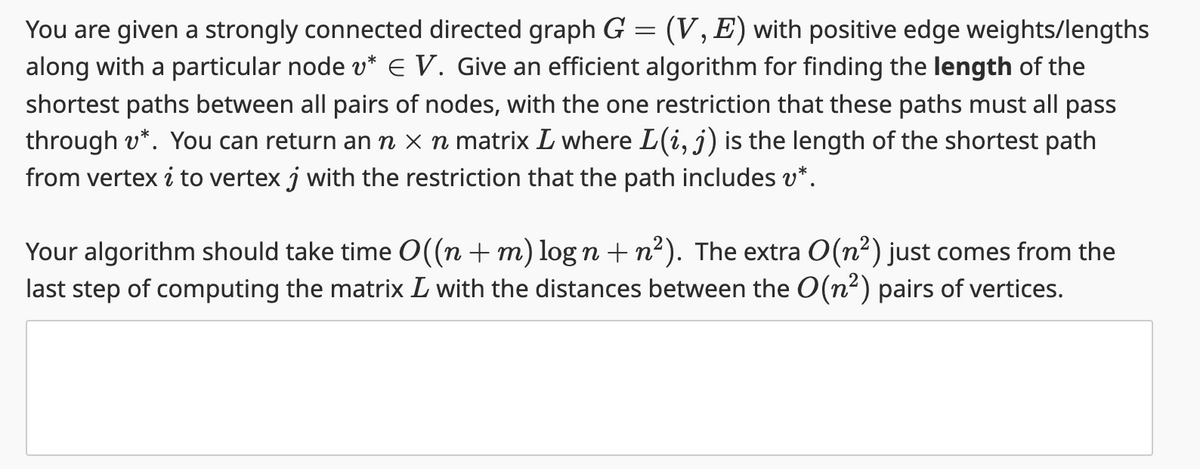You are given a strongly connected directed graph G = (V, E) with positive edge weights/lengths along with a particular node v* € V. Give an efficient algorithm for finding the length of the shortest paths between all pairs of nodes, with the one restriction that these paths must all pass through v*. You can return an ʼn x n matrix L where L(i, j) is the length of the shortest path from vertex i to vertex j with the restriction that the path includes v*. Your algorithm should take time O((n + m) log n + n²). The extra O(n²) just comes from the last step of computing the matrix I with the distances between the O(n²) pairs of vertices.
You are given a strongly connected directed graph G = (V, E) with positive edge weights/lengths along with a particular node v* € V. Give an efficient algorithm for finding the length of the shortest paths between all pairs of nodes, with the one restriction that these paths must all pass through v*. You can return an ʼn x n matrix L where L(i, j) is the length of the shortest path from vertex i to vertex j with the restriction that the path includes v*. Your algorithm should take time O((n + m) log n + n²). The extra O(n²) just comes from the last step of computing the matrix I with the distances between the O(n²) pairs of vertices.
Database System Concepts
7th Edition
ISBN:9780078022159
Author:Abraham Silberschatz Professor, Henry F. Korth, S. Sudarshan
Publisher:Abraham Silberschatz Professor, Henry F. Korth, S. Sudarshan
Chapter1: Introduction
Section: Chapter Questions
Problem 1PE
Related questions
Question
a) write the
b) Briefly explain why the algorithm solves the problem, and the correctness
c ) State and briefly explain the running time of your algorithm

Transcribed Image Text:=
You are given a strongly connected directed graph G (V, E) with positive edge weights/lengths
along with a particular node v* € V. Give an efficient algorithm for finding the length of the
shortest paths between all pairs of nodes, with the one restriction that these paths must all pass
through v*. You can return an ʼn × ʼn matrix L where L(i, j) is the length of the shortest path
from vertex i to vertex j with the restriction that the path includes v*.
Your algorithm should take time O((n + m) log n + n²). The extra O(n²) just comes from the
last step of computing the matrix L with the distances between the O(n²) pairs of vertices.
Expert Solution
This question has been solved!
Explore an expertly crafted, step-by-step solution for a thorough understanding of key concepts.
This is a popular solution!
Trending now
This is a popular solution!
Step by step
Solved in 5 steps

Knowledge Booster
Learn more about
Need a deep-dive on the concept behind this application? Look no further. Learn more about this topic, computer-science and related others by exploring similar questions and additional content below.Recommended textbooks for you

Database System Concepts
Computer Science
ISBN:
9780078022159
Author:
Abraham Silberschatz Professor, Henry F. Korth, S. Sudarshan
Publisher:
McGraw-Hill Education

Starting Out with Python (4th Edition)
Computer Science
ISBN:
9780134444321
Author:
Tony Gaddis
Publisher:
PEARSON

Digital Fundamentals (11th Edition)
Computer Science
ISBN:
9780132737968
Author:
Thomas L. Floyd
Publisher:
PEARSON

Database System Concepts
Computer Science
ISBN:
9780078022159
Author:
Abraham Silberschatz Professor, Henry F. Korth, S. Sudarshan
Publisher:
McGraw-Hill Education

Starting Out with Python (4th Edition)
Computer Science
ISBN:
9780134444321
Author:
Tony Gaddis
Publisher:
PEARSON

Digital Fundamentals (11th Edition)
Computer Science
ISBN:
9780132737968
Author:
Thomas L. Floyd
Publisher:
PEARSON

C How to Program (8th Edition)
Computer Science
ISBN:
9780133976892
Author:
Paul J. Deitel, Harvey Deitel
Publisher:
PEARSON

Database Systems: Design, Implementation, & Manag…
Computer Science
ISBN:
9781337627900
Author:
Carlos Coronel, Steven Morris
Publisher:
Cengage Learning

Programmable Logic Controllers
Computer Science
ISBN:
9780073373843
Author:
Frank D. Petruzella
Publisher:
McGraw-Hill Education